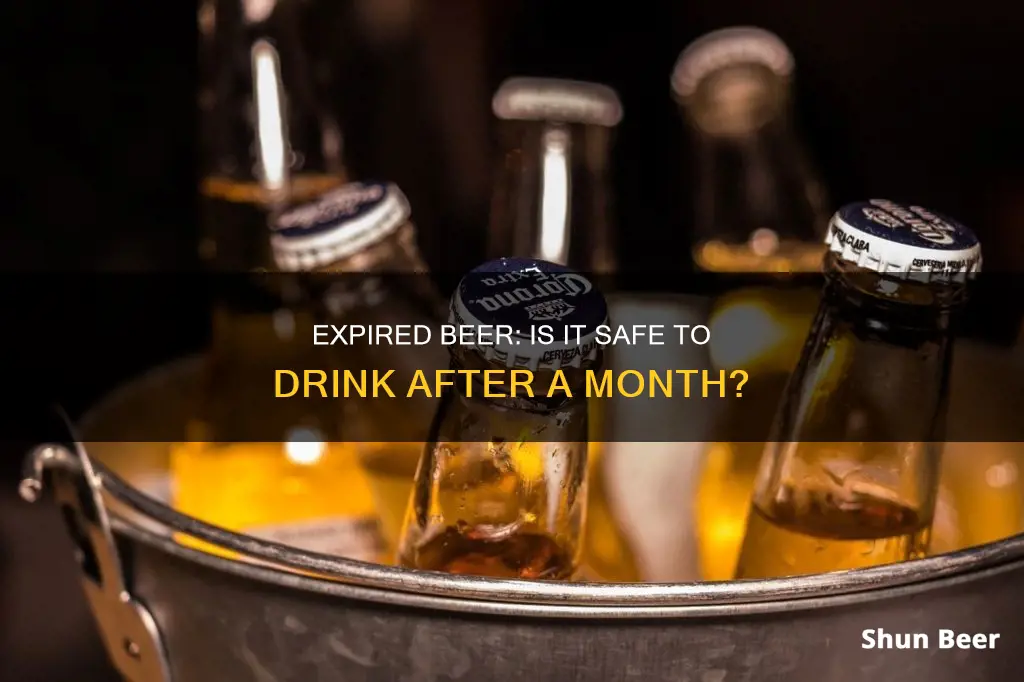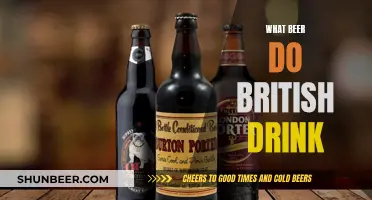
Beer is produced with expiry dates, but these are more of a guideline on quality than safety. Beer doesn't spoil, and it's highly unlikely to make you sick, even if it's been sitting on the shelf for years. The worst thing that will happen is that it will taste bad. However, the flavour of beer does change over time, and it can become overly sweet or develop a vinegary taste. Beers with higher alcohol content tend to last longer than lighter beers, and hoppy beers like IPAs are best consumed fresh.
| Characteristics | Values |
|---|---|
| Is one-month expired beer safe to drink? | Yes, it is safe to drink. Beer doesn't "go bad" in the same way as other foods and drinks. |
| Will it taste bad? | Probably. The taste of beer changes over time, and it is unlikely to taste as good as it once did. |
| What affects the taste of beer? | Oxygen, heat, and light. |
| How long does beer last? | Beer has a shelf life of about a day once opened. Unopened, beer can last 5-9 months beyond the expiration date listed on the label at room temperature, and up to 2-3 years in a refrigerator. |
| How can I tell if my beer has gone bad? | There may be a bad aroma, or it may be missing the usual 'pssst' sound and foaming when you open it. There may also be excessive sediment at the bottom of the bottle. |
What You'll Learn

Beer doesn't spoil, but it can lose its flavour and go flat
Beer is produced with expiry dates, but these are more of a guideline on quality than safety. Beer doesn't spoil, but it can lose its flavour and go flat. The fermentation process used in brewing, as well as its low pH level and alcohol content, make beer an unfriendly environment for harmful microorganisms. Even if a beer sits on the shelf for years, as long as it's sealed, it's unlikely to make you sick.
However, over time, the taste of beer will change, and it could become flat. The three main culprits that can cause flavours to go awry are oxygen, heat, and light. Oxygen interacts with the compounds from malt, yeast, and hops, causing oxidation and a disappointing papery or stale taste. Heat speeds up oxidation, so storing beer in a refrigerator is best. Light exposure can also cause a chemical reaction, resulting in an unpleasant skunky taste.
Some beers, like porters and stouts, can improve with age if kept in cool, dark storage. However, IPAs gradually lose their flavour and are best drunk fresh.
If you're unsure about drinking an expired beer, check for signs of spoilage. If the can is squishy, the beer smells skunky, or there is rust or flakes in the liquid, it's best to discard it.
The Working of Beer Cup Filling Stations Simplified
You may want to see also

It's safe to drink, but it might taste bad
Beer typically has a "best before" date, which is more of a guideline on quality than safety. This means that the beer will start to lose its quality after the stated date, but it is still safe to consume. The exception to this is if the beer has been left unrefrigerated for a long period of time, or if the seal has been broken, causing the beer to lose its fizz.
The fermentation process used in brewing, as well as the low pH level and alcohol content of beer, make it an unfriendly environment for microorganisms. This means that even if a beer sits on the shelf for years, as long as it is sealed, it is unlikely to make you sick.
However, the taste of beer can change over time, and it may not be as refreshing as when it was fresh. This is especially true for hoppy beers like IPAs, which are best consumed as close to the "born-on" date as possible to take full advantage of their delicious hoppy goodness.
If you're wondering if that one-month-expired beer is safe to drink, the answer is probably yes. But be prepared for a potential change in taste and quality.
To maintain the freshness of your beer, it is recommended to store it in a cool, dark place, preferably a refrigerator. If stored properly, beer can last up to two or three years past the expiration date.
Drinking Beer While on Macrobid: What You Need to Know
You may want to see also

It's best to store beer in a cool, dark place
Beer doesn't last forever, and it's best to store it in a cool, dark place.
Beer is best stored in a cool, dark place, such as a basement or cellar. This will help to elongate its lifespan. The ideal temperature for storing beer is between 45 and 55 degrees Fahrenheit. If you don't have a basement or cellar, a cool, dark area in your home will do. Just make sure the beer is stored upright and not lying down. This will minimize the amount of surface area that will be in contact with the air trapped in the bottle.
Exposing beer to sunlight can cause it to become "skunked" or "lightstruck". This is because the UV rays create a chemical reaction in the beer, breaking down its flavor components until it smells and tastes like skunk spray. Brown bottles are best for protecting beer from sunlight, whereas clear bottles offer no protection. Green bottles only block ultraviolet light.
It's also important to keep beer away from fluorescent light, as this can trigger the same chemical reaction as sunlight. This is why it's best to store beer in a dark place.
In addition to keeping beer in a cool, dark place, it's important to minimize temperature fluctuations. While it's okay to re-chill a beer that has been previously refrigerated, you don't want to be constantly moving it from a cold to a warm environment, as this can impact its flavor.
So, if you want your beer to taste its best, be sure to store it in a cool, dark place!
Beer Drinking in California Public Parks: What's Allowed?
You may want to see also

Beer in brown glass bottles is best protected from UV light
Beer typically has a ''best before'' date, which is a guideline on quality rather than safety. After this date, the beer will start to lose its quality, but it can still be consumed. The exception to this is IPAs, which lose their flavour and aroma over time and are best drunk fresh.
If you're storing beer, it's best to keep it in the fridge until you're ready to drink it. If you don't have space, store it in a cool, dark place like a basement or cellar. Keeping beer out of sunlight and changes in temperature will help to maintain its freshness.
When it comes to packaging, beer in brown glass bottles is best protected from UV light. Brown bottles do the best job of blocking UV light, which can cause the beer to develop a ''skunky'' odour and taste. This is due to a chemical reaction that occurs when UV light comes into contact with certain hop compounds, creating a compound that smells almost identical to a skunk's defence spray.
Green and clear glass bottles, on the other hand, provide little to no protection against UV light. Their use is often a marketing decision, as clear bottles showcase the colour and texture of the beer, while green bottles were once considered a status symbol for high-quality beer. Beers with little or no hops are less susceptible to UV damage, so clear and green bottles are more commonly used for these varieties.
Exploring Jordan's Beer Culture and Drinking Laws
You may want to see also

Beer in cans is shielded from light
Beer is a popular alcoholic beverage enjoyed by millions of people worldwide. Beer typically has a 'best before' date, which is a guideline on quality rather than safety. This means that the beer will start to lose its quality after the stated date but can still be consumed. The shelf life of beer varies depending on the type of beer and storage conditions. A typical lager can be drinkable for 6-24 months after its best-before date if refrigerated, and up to 9 months if stored at room temperature. However, IPAs are best consumed sooner rather than later as they gradually lose their flavour and aroma over time.
Now, onto the main topic: why is beer in cans shielded from light?
Cans provide a complete barrier against light, ensuring that the beer remains protected. Additionally, cans are more airtight than bottles, further enhancing the preservation of the beer's flavour and freshness. The opaque nature of cans blocks out all light, making them an ideal packaging choice for beer.
Breweries may also use brown or green bottles for their beers as these darker colours offer some protection against UV rays. However, even with darker bottles, light and UV rays can still affect the beer, emphasising the importance of storing beer in a cool, dark place away from direct sunlight.
By choosing canned beer or storing bottled beer properly, consumers can help protect their beer from the negative effects of light and UV rays, ensuring a more enjoyable drinking experience.
Beer Left Out: Is It Still Safe to Drink?
You may want to see also
Frequently asked questions
Yes, you can drink beer that is past its expiration date. Beer doesn't spoil in the same way that other foods do, and it won't make you sick. However, the taste may be affected.
At room temperature, beer can last about 5 to 9 months beyond its expiration date. If it's stored in a refrigerator, it can last up to two or three years.
The fermentation process, low pH level, and alcohol content of beer make it an unfriendly environment for most microorganisms. However, beer is susceptible to oxidation, which can cause a papery or cardboard-like taste. Heat and light exposure can also affect the taste.
If the beer has lost its carbonation or has a vinegary taste, it's best to throw it out. These could be signs that the seal was broken or that bacteria has gotten into the beer.







